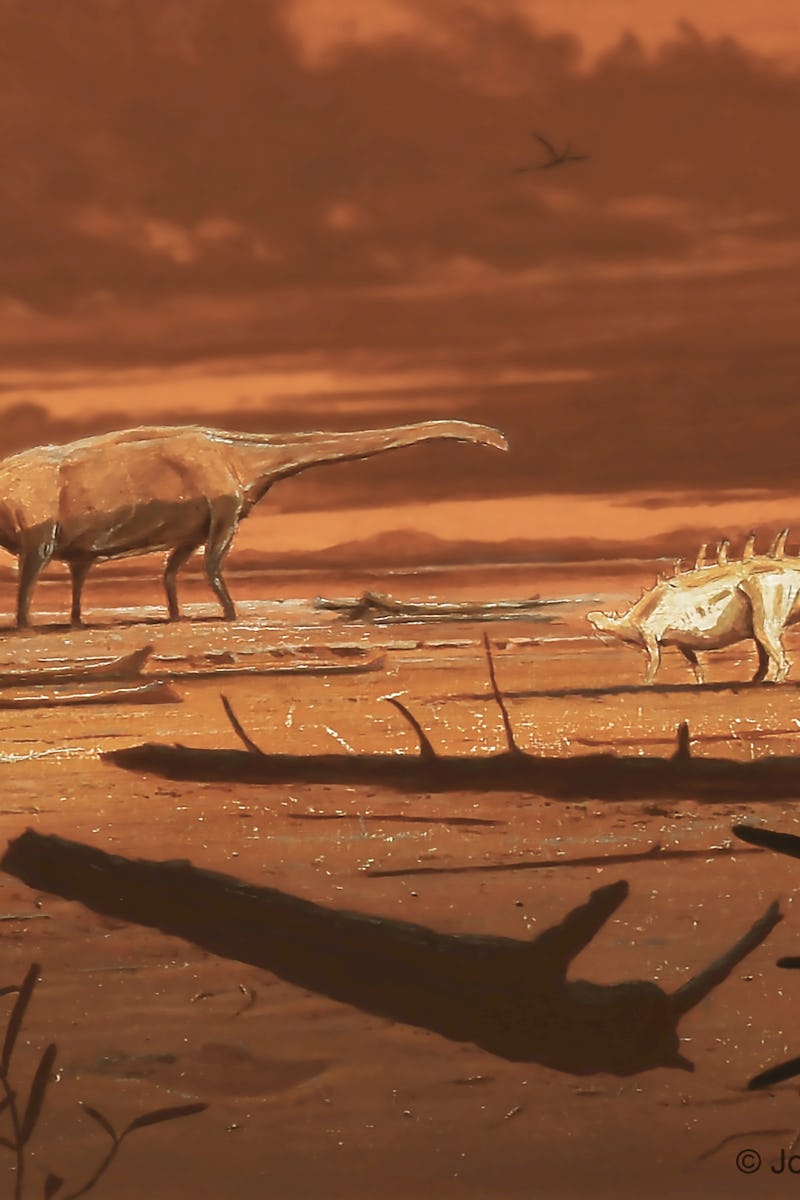
“It was... a haven for dinosaurs of all kinds: big ones, small ones, meat-eaters, plant-eaters, long-necked giants, sharp-toothed T. rex relatives, plate-backed stegosaurs…”
Paleontologists unearth a "real Jurassic Park" in Scotland
“It was... a haven for dinosaurs of all kinds: big ones, small ones, meat-eaters, plant-eaters, long-necked giants, sharp-toothed T. rex relatives, plate-backed stegosaurs…”
by Nina PullanoResearchers are one step closer to recreating the age of the dinosaurs.
In a new study, paleontologists describe 50 dinosaur footprints found in two separate locations on Scotland’s Isle of Skye.
Among them are the oldest tracks of their kind discovered anywhere in the world, likely left in the island's mud by a Stegosaurus-like, armored dinosaur that lived during the Middle Jurassic, some 174 to 163 million years ago.
This is also the first evidence paleontologists have that stegosaurians once thrived on Skye.
“These are particularly exciting because the new track sites reveal a new type of dinosaur we didn't know lived here: stegosaurs, the iconic plate-backed plant-eaters," Steve Brusatte, one of the study's authors and a researcher at the University of Edinburgh, tells Inverse.
“It's always exciting when we find new dinosaurs, especially in Scotland, where dinosaur fossils are so rare,” Brusatte says. Despite that rarity, the fossils reveal that Scotland was once a "haven" for dinosaurs — a real-life Jurassic World.
Fossil tracks left by a stegosaur on the Isle of Skye, Scotland.
The findings help researchers paint a better picture of what life was like during the Middle Jurassic Period, a key period in dinosaur evolution during which many species diversified. Until now, fossils from the time have proven scarce, Brusatte says. Most of what we know about these dinosaurs comes from more recent fossils.
In particular, the stegosaur footprints are among the "oldest fossils ever found, anywhere in the world," he says.
The study was published Wednesday in the journal PLOS ONE.
A dinosaur ecosystem, recreated
Scotland's Isle of Skye has proven itself a hotbed of fossil finds dating to this relatively understudied part of the Jurassic period, Brusatte says. These fossils enable researchers to retrace how dinosaurs evolved, including the beloved stegosaurians.
“Skye is one of the only places in the world with good fossils of Middle Jurassic dinosaurs, and these new tracks are some of the oldest stegosaurs in the world,” he says.
“They tell us stegosaurs were blossoming, diversifying, spreading around by the Middle Jurassic,” adding, “some 20 million years later the iconic Stegosaurus itself would live in North America.”
“Skye was a real Jurassic Park."
While the Jurassic Period was "the heyday of the dinosaurs," not all dinos lived at the same time — or in the same location, Brusatte says.
"Classic Jurassic dinosaurs like Stegosaurus, Brontosaurus, Brachiosaurus, and Allosaurus lived in the Late Jurassic, but in the Middle Jurassic their ancestors were living in places like Skye."
Tracks uncovered on Skye reveal a thriving dinosaur ecosystem — and the ancestor of the Stegosaurus.
Alongside the stegosaur tracks, researchers also found three-toed impressions of varying size and some larger bird-like tracks. Together, they reveal the ghostly traces of carnivorous theropods and large, herbivorous, bird-footed dinosaurs that may once have roamed alongside the stegosaurian specimen.
Jurassic Park vs Jurassic Period
Brusatte has even more interest than most in recreating what the prehistoric landscape truly looked like. He is working with filmmakers on the latest Jurassic World movie, slated for release in 2021.
So, how does the portrayal of the Jurassic period in the popular film franchise match up with the latest research?
“Skye was a real Jurassic Park,” Brusatte says. “It was hot, humid, subtropical, shimmering with beaches and lagoons, a haven for dinosaurs of all kinds: big ones, small ones, meat-eaters, plant-eaters, long-necked giants, sharp-toothed T. rex relatives, plate-backed stegosaurs…”
Brusatte says he is excited about the film, but he can’t reveal too much about what dinosaurs might feature in the movie — for now.
“It's a great honor, and a lot of fun, to be the consultant on the upcoming film,” he says.
“All I will say now is that I am very excited about it, and dinosaur fans are going to love it.”
Abstract: Dinosaur fossils from the Middle Jurassic are rare globally, but the Isle of Skye (Scotland, UK) preserves a varied dinosaur record of abundant trace fossils and rare body fossils from this time. Here we describe two new tracksites from Rubha nam Brathairean (Brothers’ Point) near where the first dinosaur footprint in Scotland was found in the 1980s. These sites were formed in subaerially exposed mudstones of the Lealt Shale Formation of the Great Estuarine Group and record a dynamic, subtropical, coastal margin. These tracksites preserve a wide variety of dinosaur track types, including a novel morphotype for Skye: Deltapodus which has a probable stegosaur trackmaker. Additionally, a wide variety of tridactyl tracks shows evidence of multiple theropods of different sizes and possibly hints at the presence of large-bodied ornithopods. Overall, the new tracksites show the dinosaur fauna of Skye is more diverse than previously recognized and give insight into the early evolution of major dinosaur groups whose Middle Jurassic body fossil records are currently sparse